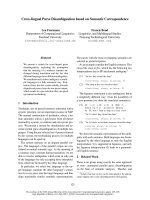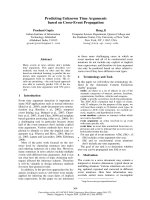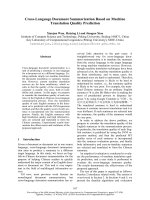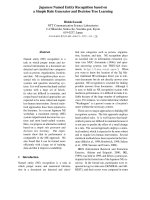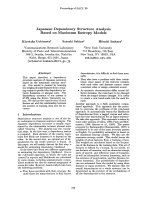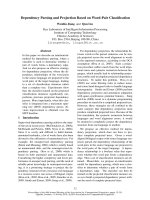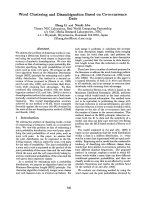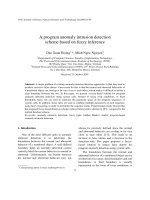Báo cáo " A program anomaly intrusion detection scheme based on fuzzy inference " potx
Bạn đang xem bản rút gọn của tài liệu. Xem và tải ngay bản đầy đủ của tài liệu tại đây (212.58 KB, 11 trang )
VNU Journal of Science, Natural Sciences and Technology 24 (2008) 71-81
71
A program anomaly intrusion detection
scheme based on fuzzy inference
Dau Xuan Hoang
1,
*, Minh Ngoc Nguyen
2
1
Department of Computer Science, Faculty of Information Technology,
The Posts and Telecommunications Institute of Technology (PTIT),
122 Hoang Quoc Viet, Cau Giay, Hanoi, Vietnam
2
Vietnam Posts and Telecommunications (VNPT), 10
th
Floor, Ocean Park Building,
No.1 Dao Duy Anh, Dong Da, Hanoi, Vietnam
Received 31 October 2007
Abstract. A major problem of existing anomaly intrusion detection approaches is that they tend to
produce excessive false alarms. One reason for this is that the normal and abnormal behaviour of
a monitored object can overlap or be very close to each other, which makes it difficult to define a
clear boundary between the two. In this paper, we present a fuzzy-based scheme for program
anomaly intrusion detection using system calls. Instead of using crisp conditions, or fixed
thresholds, fuzzy sets are used to represent the parameter space of the program sequences of
system calls. In addition, fuzzy rules are used to combine multiple parameters of each sequence,
using fuzzy reasoning, in order to determine the sequence status. Experimental results showed that
the proposed fuzzy-based detection scheme reduced false positive alarms by 48%, compared to the
normal database scheme.
Keywords: anomaly intrusion detection, fuzzy logic, hidden Markov model, program-based
anomaly intrusion detection.
1. Introduction
∗
∗∗
∗
One of the most difficult tasks in anomaly
intrusion detection is to determine the
boundaries between the normal and abnormal
behavior of a monitored object. A well-defined
boundary helps an anomaly detection system
correctly label the current behavior as normal or
abnormal. Unfortunately, the border between
the normal and abnormal behavior may not
_______
∗
Corresponding author. E-mail:
always be precisely defined since the normal
and abnormal behavior can overlap or be very
close to each other [1-3]. This leads to an
increase in false alarms and a decrease in the
detection rate. This paper proposes a fuzzy-
based solution to reduce false alarms for
program anomaly detection using system calls.
The boundaries between the normal and
abnormal behavior of a monitored object can be
divided into two types: hard boundaries and soft
boundaries. A hard boundary is usually
represented in the form of crisp conditions or
D.X. Hoang, M.N. Nguyen / VNU Journal of Science, Natural Sciences and Technology 24 (2008) 71-81
72
fixed thresholds. For example, in the normal
database detection scheme [4], a short sequence
of system calls is labeled as normal if it is seen
in the training set. Otherwise, it is classified as
abnormal. In the second test of the hidden
Markov model-based (HMM) two-layer
detection scheme [5], a probability threshold
ˆ
P
is used to determine the status of short
sequences. If a sequence's probability P,
generated by the HMM model, is equal or
greater than the probability threshold (P ≥
ˆ
P
), it
is considered normal. Otherwise, it is
considered abnormal (P <
ˆ
P
).
In contrast, a soft boundary is usually
represented by fuzzy sets and rules, instead of
crisp conditions, or fixed thresholds. In [1], five
fuzzy sets are used to represent the space of each
input network data source. In addition, a set of
fuzzy rules is defined to combine a set of inputs
in order to produce an output which is the status
of current network activity. In [6], a set of fuzzy
association rules is generated to represent the
normal behavior of network traffic.
Anomaly detection approaches, based on
soft boundaries in general, or fuzzy sets and
rules in particular, can produce better detection
results than those based on hard boundaries,
because of the following reasons:
• Since normalcy and abnormalcy are not
truly crisp concepts, it is difficult to define a
hard boundary that can create a sharp
distinction between the normal and
abnormal. Therefore, it is natural to use
fuzzy sets to define a “soft” border between
them [1,3]. In fuzzy logic terms, the normal
is represented by the degree of normalcy.
Similarly, the abnormal is represented by the
degree of abnormalcy.
• Anomaly detection systems, based on fuzzy
inference, can combine inputs from multiple
sources, which leads to better detection
performance [1].
Although the application of fuzzy inference
in anomaly intrusion detection is still in an
early stage, promising results have been
reported by several fuzzy-based anomaly
detection approaches. Cho [7] reported a high
detection rate and a significant reduction in the
false positive rate, when using fuzzy inference
to combine inputs from three separate HMM
models deployed in a user anomaly detection
system. Luo et al [8] presented a real-time
anomaly intrusion detection system, in which a
set of fuzzy frequent episode rules was mined
from the training data to represent the
abnormality. The proposed approach [8]
reportedly had lower false positive rates than
those, based on non-fuzzy frequent episode
rules. Good detection results were also reported
in [1,3,6].
In this paper, we propose a fuzzy-based
detection scheme which is based on the HMM-
based two-layer detection scheme proposed in
our previous work [5], and the normal database
detection scheme [4]. The proposed detection
scheme aims at reducing false alarms and
increasing the detection rate. We employ fuzzy
inference to evaluate each short sequence of
system calls, by combining the sequence’s
multiple parameters. Each short sequence is
represented by three parameters: the sequence
probability generated by the HMM model, the
sequence distance and the sequence frequency
produced by the normal database [4]. Instead of
using crisp conditions or fixed thresholds, a
group of fuzzy sets is defined to represent each
parameter's space. A set of fuzzy rules is
created to combine these input sequence
parameters, in order to produce an output of the
sequence status. Experimental results showed
that our fuzzy-based detection scheme reduced
false alarms significantly, compared to the two-
layer detection scheme [5] and the normal
database detection scheme [4].
D.X. Hoang, M.N. Nguyen / VNU Journal of Science, Natural Sciences and Technology 24 (2008) 71-81
73
The rest of this paper is organized as
follows: Section II gives a brief introduction to
fuzzy logic, fuzzy sets and fuzzy rules. Section
III describes the proposed fuzzy-based scheme
for program anomaly intrusion detection using
system calls. Section IV presents some
experimental results and discussion. Section V
is our conclusion.
2. Fuzzy logic
Fuzzy logic is an extension of Boolean
logic, which specifically deals with the concept
of partial truth. The mathematical principles of
fuzzy sets and fuzzy logic were first presented
in 1965 by professor L.A. Zadeh [4]. Since
then, fuzzy logic has rapidly become one of the
most successful technologies in the
development of control systems. The
application of fuzzy logic is ranging from
simple, small and embedded micro-controllers
to large data acquisition and control systems
[9].
While a truth value in classical logic can
always be expressed in binary terms (0 or 1,
True or False, Yes or No), a truth value in fuzzy
logic is represented by the degree of truth. The
degree of truth can be any value in the range
[0.0, 1.0], with 0.0 representing absolute
Falseness and 1.0 representing absolute Truth.
2.1. Fuzzy sets
Mathematically, a fuzzy set A is defined as
follows:
A = {(x,
µ
A
(x)) | x ∈ U }
where
µ
A
(x) is the membership function of the
fuzzy set A, and U is the Universe of Discourse.
A Universe of Discourse, or Universe in short,
is the range of all possible values for an input to
a fuzzy system.
2.2. Fuzzy rules
Rules in fuzzy logic are used to combine
and interpret inputs in order to produce an
output. Fuzzy rules are usually expressed in the
IF/THEN form as:
IF <variable> IS <fuzzy set> THEN <output>
A rule is said to fire if its truth value is
greater than 0. It is also noted that there is no
“ELSE” clause in a fuzzy rule. All available
rules in a fuzzy control system are evaluated
because an input can belong to more than one
fuzzy set.
Like classical logic, fuzzy logic also
supports AND, OR and NOT operators, which
can be used to create more complex fuzzy rules.
Let x and y be two fuzzy variables, and
µ
(x) and
µ
(y) be the degrees of membership of x and y,
respectively, AND, OR and NOT operators are
defined as:
x AND y = min(
µ
(x),
µ
(y))
x OR y = max(
µ
(x),
µ
(y))
NOT x = (1 -
µ
(x))
For more on fuzzy logic, interested readers
are referred to [9],[10].
3. The proposed fuzzy-based program
anomaly detection scheme
3.1. The proposed fuzzy-based detection scheme
Fig. 1 shows the proposed fuzzy-based
detection scheme which is developed in two
stages: (a) training stage and (b) testing stage.
In the training stage, the detection model is
constructed from the training data which is
normal traces of system calls of a program. In
the testing stage, the constructed detection
model is used to evaluate test traces of system
calls in order to find possible intrusions. The
two stages of the proposed scheme can be
described as follows:
D.X. Hoang, M.N. Nguyen / VNU Journal of Science, Natural Sciences and Technology 24 (2008) 71-81
74
Fig. 1. The proposed fuzzy-based detection scheme:
(a) Training stage and (b) Testing stage.
• Training stage: a normal database, an HMM
model and fuzzy sets are built from training
data.
-
Normal database: The database is an
ordered list of all unique short sequences
of system calls found in training data.
The database is created from normal
traces of system calls using the method
given in [4]. Each short sequence in the
normal database has k system calls. In
addition, the occurrence frequency of
each short sequence in training data is
also recorded in the normal database.
-
HMM model: The HMM model is
trained using normal traces of system
calls, based on the HMM incremental
training scheme, given in [11].
-
The fuzzy sets are created, as discussed
in Section 0.0.
•
Testing stage: First, short sequences are
formed from test traces of system calls using
the sliding window method [4]. The
sequence length is k system calls. Then, each
short sequence is evaluated in two steps as
follows:
-
Evaluation of the short sequence by the
normal database and by the HMM model:
In this step, the normal database and the
HMM model are used to compute the
input parameters for the fuzzy inference
engine.
-
Classification of the test sequence by the
fuzzy inference engine: In this step, the
fuzzy inference engine applies the fuzzy
sets and rules to interpret the input
parameters in order to produce the output
which is the status of the short sequence:
normal or abnormal.
3.2. Fuzzy inference for sequence classification
As discussed in Section III.A, the fuzzy
inference engine is used to evaluate each short
sequence to find anomalies by combining
multiple sequence parameters. Fig. 2 shows the
fuzzy inference engine for the classification of
short sequences of system calls. The engine
accepts the sequence's parameters as the input,
and then applies the fuzzy sets and rules to
produce the sequence's status as the output. The
sequence parameters include the sequence
probability P generated by the HMM model,
and the sequence distance D and frequency F
produced by the normal database.
Creation of fuzzy sets and rules
As shown in Fig. 2, fuzzy sets and rules are
used by the fuzzy inference engine to interpret
the input and generate the output.
Creation of fuzzy sets
We empirically created fuzzy sets to
represent the space of each sequence parameter
as follows:
D.X. Hoang, M.N. Nguyen / VNU Journal of Science, Natural Sciences and Technology 24 (2008) 71-81
75
•
Four fuzzy sets, namely Very Low, Low,
High and Very High, are created for the
sequence probability P, to represent very
low, low, high and very high sequence
probabilities, respectively.
•
Four fuzzy sets, namely Zero, Small,
Medium and Large, are created to represent
zero (for matched sequences), small,
medium and large sequence distances,
respectively.
•
Three fuzzy sets, namely Low, Medium and
High, are created to represent low, medium
and high sequence frequencies, respectively.
•
Two fuzzy sets, namely Normal and
Abnormal, are created to represent the space
of the output sequence anomaly score
parameter. The anomaly score fuzzy sets are
used in the defuzzification process to
convert the output fuzzy set to the actual
anomaly score of the sequence.
Creation of fuzzy rules
Since the input sequence parameters of the
fuzzy rules, which include probability P,
distance D and frequency F, are generated by
the HMM model and the normal database,
our fuzzy rules inherit the assumptions used by
the normal database and the HMM-based
detection schemes. These assumptions are as
follows:
•
A sequence, which is produced with a likely
probability by the HMM model, is
considered to be normal.
•
A sequence, which is produced with an
unlikely probability by the HMM model, is
considered to be abnormal.
•
A mismatched sequence is more suspicious
than a matched sequence. The larger the
distance between a test sequence and normal
sequences is the more likely the test
sequence is abnormal.
•
A matched sequence with a low occurrence
frequency is more suspicious than a
sequence with high occurrence frequency.
Fig. 2. The fuzzy inference engine for the
classification of short sequences of system calls.
Based on the above assumptions, we
manually devised a set of 17 fuzzy rules for the
sequence classification. An example of such a
rule reads “IF probability IS Low AND distance
IS Zero AND frequency IS Low THEN the test
sequence IS abnormal”. We do not present all
rules in this paper due to space limitation.
Sequence classification using fuzzy
reasoning
The fuzzy reasoning process, as shown in
Fig. 2, evaluates each sequence of system calls
in three phases: fuzzification, fuzzy inference
and defuzzification. Fuzzification is the process
of transforming crisp input values into
linguistic values which usually are fuzzy sets.
There are two tasks performed in the
fuzzification process: input values are
converted into linguistic values which are
represented by fuzzy sets, and membership
functions are applied to compute the degree of
truth for each matched fuzzy set.
Defuzzification is the process of
transforming the fuzzy value into a crisp value.
In our fuzzy inference engine, the output
anomaly score fuzzy set is defuzzified to
produce the sequence's anomaly score. There
D.X. Hoang, M.N. Nguyen / VNU Journal of Science, Natural Sciences and Technology 24 (2008) 71-81
76
are many defuzzification techniques available,
such as centroid method, max-membership
method and weighted average method. We used
the max-membership method to compute the
crisp output from the output fuzzy set.
In the fuzzy inference phase, all rules in the
fuzzy rule-base are applied to input parameters
in order to produce an output. For each rule,
first, each premise is evaluated, and then all
premises connected by an AND are combined
by taking the smallest value of their degree of
membership as the combination value of rule's
truth value. The final output fuzzy set of the
fuzzy rule-base is the OR combination of results
of all individual rules that fire. It is noted that
the truth value of a rule that fires is non-zero.
The output fuzzy set is defuzzified to produce a
crisp output value.
4. Experimental results and discussion
4.1. Data set
We used sendmail traces of system calls
collected in a synthetic environment, as given
in [12]. The format of system call traces and the
data collection procedures were discussed in
[4]. The data sets include:
•
Normal traces are those collected during the
program's normal activity. Normal traces of
the sendmail program include 2 traces with
the total of 1,595,612 system calls.
•
Abnormal traces are those that come from a
program's abnormal runs generated by
known intrusions. In the case of sendmail
abnormal traces, they consist of 1 trace of
sm5x intrusion, 1 trace of sm565a intrusion,
2 traces of syslog-local, and 2 traces of
syslog-remote intrusion.
4.2. Experimental design
In order to measure the detection rate and
the false alarm rate of our fuzzy-based detection
model, our experiments were designed as
follows:
•
Measurement of the false positive rate: In
this test, we use the proposed fuzzy-based
detection scheme to classify normal traces of
system calls, which were not used in the
construction of the normal database, the
HMM model and the fuzzy sets. Since the
normal traces do not contain any intrusions,
any reported alarms are considered false
positives. This experiment was set up as
follows:
- Select first 1,000,000 system calls of
sendmail normal traces as the full
training set.
- Form 4 training sets which account for
30%, 50%, 80% and 100% of the size of
the full training set.
- Construct normal databases and HMM
models from these training sets. The
chosen values for the sequence length are
k = 5, 11 and 15 system calls.
- For each training set and on each selected
sequence length, construct membership
functions to fuzzy sets of three sequence
parameters, as discussed in Section III.B.
- Select three test traces, each trace of
50,000 system calls from the sendmail
normal traces, which are not used in the
training process, to test for false positive
alarms of our scheme, the normal
database scheme [4] and the two-layer
scheme [5]. Reported abnormal short
sequences are counted for each test trace.
•
Measurement of anomaly signals and the
detection rate: In this test, we use the
proposed fuzzy-based scheme to classify
abnormal traces of system calls to find
possible intrusions. Since the abnormal
traces have been collected from the
D.X. Hoang, M.N. Nguyen / VNU Journal of Science, Natural Sciences and Technology 24 (2008) 71-81
77
program's abnormal runs, generated by
known intrusions, reported alarms in this
case can be considered true alarms or
detected intrusions. This experiment was
designed as follows:
-
Construct a normal database and an
HMM model for sendmail program from
normal traces of 1,000,000 system calls.
We choose the sequence length k = 11 to
construct the normal database from
normal traces, and to form short
sequences from abnormal traces for
testing.
-
Construct membership functions to fuzzy
sets of the three sequence parameters, as
discussed in Section 0.
-
Use the proposed fuzzy-based detection
scheme to evaluate abnormal traces to
find abnormal sequences.
-
Use temporally local regions to group
individual abnormal sequences to
measure the anomaly signals. The
selected region length is r = 20.
4.3. Experimental results
False positive rate
Table 1 shows the overall false positive rate
for three test traces with a total of 150,000
system calls (each trace consisting of 50,000
system calls), as reported by the normal
database scheme [4], by the two-layer detection
scheme [5] and by the fuzzy-based detection
scheme, on different training sets with the
sequence length k = 5, 11 and 15. The total
number of short sequences in the test traces is
dependent on the sequence length and is also
given in Table 1.
Table 1. Overall false positive rate of the normal database scheme,
the two-layer detection scheme and the fuzzy-based detection scheme
with the short sequence length, k = 5, 11 and 15
Training data sets
(% of full data set)
Normal database
scheme [1] (%)
Two-layer
scheme [5] (%)
Fuzzy-based
scheme (%)
Sequence length, k = 5; 3 test traces with the total of 149,988 sequences
30% 0.131 0.112 0.067
50% 0.099 0.079 0.057
80% 0.094 0.069 0.049
100% 0.094 0.069 0.049
Sequence length, k = 11; 3 test traces with the total of 149,970 sequences
30% 0.194 0.170 0.099
50% 0.155 0.115 0.081
80% 0.150 0.107 0.077
100% 0.147 0.107 0.077
Sequence length, k = 15; 3 test traces with the total of 149,958 sequences
30% 0.225 0.164 0.107
50% 0.176 0.121 0.091
80% 0.174 0.116 0.085
100% 0.171 0.116 0.085
It can be seen from Table 1 that the false
positive rate of the fuzzy-based detection
scheme is much lower than that of the normal
database scheme [4]. For example, the fuzzy-
based detection scheme produced 48.23%,
48.89% and 50.96% fewer false positive alarms
than the normal database scheme, for the
training set of 80% of full set, with the
D.X. Hoang, M.N. Nguyen / VNU Journal of Science, Natural Sciences and Technology 24 (2008) 71-81
78
sequence length k = 5, k = 11 and k = 15,
respectively.
It is also noted that there is a significant
reduction in the false positive rate of the fuzzy-
based detection scheme, compared to that of the
two-layer detection scheme [5]. For example,
the fuzzy-based detection scheme produced
29.81%, 28.13% and 26.44% fewer false
positive alarms than the two-layer detection
scheme for the training set of 80% of full set,
with sequence length k = 5, k = 11 and k = 15,
respectively (refers to Table 1).
Fig. 3 shows the dependence of the false
positive rate on the size of the training sets with
the sequence length k = 11. When the size of
the training set increases, the false positive rate
of the normal database scheme [4] and the two-
layer scheme [5] decreases considerably,
especially from the training set of 30% of the
full set to the set of 50% of the full set. Since
the fuzzy-based scheme has already achieved a
low false positive rate at the set of 30% of the
full set, there is only a small reduction in the
false positive rate when the size of the training
set increases.
Fig. 3. The relationship between the size of
training sets and the false positive rate with
k = 11.
Anomaly signals and the detection rate
Table 2 shows a summary of the detection
results of the two-layer scheme and the fuzzy-
based scheme for some abnormal traces which
were generated by some known intrusions. The
detection performance results of the normal
database scheme are taken from Table 3 of [4].
Similar to the anomaly signal measurement
method described in [5], we measure anomaly
signals based on temporally local regions. The
anomaly score A of a region is computed as the
ratio of the number of detected abnormal short
sequences in the region to the length of the
region r. The average of anomaly scores is
computed over abnormal regions that have the
anomaly score A greater than the region score
threshold  (A ≥ Â), where  = 40.0%.
Table 2. Detection results produced by the normal database scheme, by the two-layer scheme and
by the fuzzy-based scheme for some abnormal traces
% of detected
abnormal regions
Average of scores of
abnormal regions
Name of test
abnormal
traces
% detected
abnormal
sequences by [1]
Two
layer (%)
Fuzzy-
based (%)
Two
layer (%)
Fuzzy-
based (%)
sm565a 0.60 38.46 76.92 68.00 88.00
sm5x 2.70 31.58 67.11 60.42 72.55
syslog-local No.1 5.10 12.00 60.00 73.33 84.67
syslog-local No.2 1.70 16.67 60.26 71.54 86.49
syslog-remote No.1 4.00 28.26 67.39 72.31 86.53
syslog-remote No.2 5.30 24.68 61.04 74.74 83.40
D.X. Hoang, M.N. Nguyen / VNU Journal of Science, Natural Sciences and Technology 24 (2008) 71-81
79
It can be seen from Table 2 that the fuzzy-
based scheme produced significantly better
detection results than the two-layer scheme [5],
in terms of the number of detected abnormal
regions and the generated anomaly signal level.
For the “sm5x” intrusion trace, the rates of
detected abnormal regions are 31.58% and
67.11% by the two-layer scheme and fuzzy-
based scheme, respectively. Also for this test
trace, the fuzzy-based scheme generated the
average anomaly score of 72.55%, compared to
the average anomaly score of 60.42% produced
by the two-layer scheme.
Fig. 4 and Fig. 5 show the anomaly signals
produced by the two-layer scheme [5] and the
fuzzy-based scheme for syslog-local No. 1 and
syslog-remote No. 1 abnormal traces,
respectively, with the sequence length k = 11. It
is noted that anomaly signals are measured
based on temporally local regions for both
schemes. It can be seen from these figures that
the proposed fuzzy-based scheme generated
much stronger and clearer anomaly signals than
the two-layer scheme [5].
Fig. 4. Anomaly signal generated for syslog-local abnormal
trace No. 1 by the two-layer and fuzzy-based schemes.
Fig. 5. Anomaly signal generated for syslog-remote abnormal
trace No. 1 by the two-layer and fuzzy-based schemes.
D.X. Hoang, M.N. Nguyen / VNU Journal of Science, Natural Sciences and Technology 24 (2008) 71-82
71
80
4.4. Discussion
The proposed fuzzy-based detection scheme
generated much fewer false positive alarms than
the normal database scheme [4], as shown in
Table 1. For example, the false positive rate of
the normal database scheme is 0.174%, as
opposed to 0.085% of the proposed scheme, or
a reduction of 50.96%, when using the training
set of 50% of the full set, with k = 15.
It is also noted that the proposed detection
scheme achieved a much lower false positive
rate on small-size training sets than the normal
database scheme [4]. On the training set of 30%
of the full set, the false positive rate of
proposed detection model is lower than that of
the normal database scheme on the full training
set. This means that the proposed detection
model requires significant less training data to
achieve a better level of false positive rates than
the normal database scheme [4].
According to experimental results presented
in Table 2, our detection scheme correctly
detected all intrusions embedded in all
abnormal traces tested. In contrast, the normal
database scheme [4] missed the sm565a
intrusion, with only 0.6% of abnormal
sequences detected. This scheme [4] possibly
also missed the syslog-local intrusion,
embedded in syslog-local trace No. 2, with just
1.7% of abnormal sequences detected.
The fuzzy inference engine plays an
important role in the reduction of false positive
alarms and the increase of the detection rate.
The fuzzy inference engine that incorporates
multiple sequence information, generated by the
normal database and by the HMM model,
accurately classifies the sequence. This reduces
the false alarms and increases the detection rate.
5. Conclusion
In this paper, we presented a fuzzy-based
scheme for program anomaly intrusion
detection using system calls. The proposed
fuzzy-based detection scheme is based on the
two-layer detection scheme [5] and the normal
database detection scheme [4]. Instead of using
crisp conditions, or fixed thresholds, fuzzy sets
are created to represent the space of each
sequence parameters. A set of fuzzy rules is
created to combine multiple sequence parameters
in order to determine the sequence status,
through a fuzzy reasoning process. Experimental
results showed that the proposed detection
scheme reduced false positive alarms by about
48% and 28%, compared to the normal database
scheme [4] and the two-layer scheme [5],
respectively. The proposed detection scheme
also generated much stronger anomaly signals,
compared to the normal database scheme [4] and
the two-layer scheme [5].
References
[1] J.E. Dickerson, J. Juslin, O. Koukousoula, J.A.
Dickerson, “Fuzzy Intrusion Detection,” in the
Proceedings of North American Fuzzy Information
Processing Society, Vancouver, Canada, July 25,
(2001) 1506.
[2] J. Gòmez, D. Dasgupta, “Evolving Fuzzy Classifiers
for Intrusion Detection,” in the Third Annual IEEE
Workshop on Information Assurance, New Orleans,
Louisiana, USA, June 17-19, 2002.
[3] J. Gòmez, F. Gonzàlez, D. Dasgupta, “An Immuno-
Fuzzy Approach to Anomaly Detection,” in the IEEE
International Conference on Fuzzy Systems, Vol.2,
May 25-28 (2003) 1219.
[4] S. Forrest, S.A. Hofmeyr, A. Somayaji, T.A.
Longstaff, "A sense of self for Unix processes," in the
Proceedings of 1996 IEEE Symposium on Computer
Security and Privacy, 1996.
[5] X.D. Hoang, J. Hu, P. Bertok, "A multi-layer model
for anomaly intrusion detection using program
sequences of system calls," in IEEE International
D.X. Hoang, M.N. Nguyen / VNU Journal of Science, Natural Sciences and Technology 24 (2008) 71-81
81
Conference on Network – IEEE ICON2003, Sydney,
Australia, September (2003) 531.
[6] G. Florez, S.M. Bridges, R.B. Vaughn, “An
Improved Algorithm for Fuzzy Data Mining for
Intrusion Detection,” in the 2002 Annual Meeting of
the North American on Fuzzy Information Processing
Society, June 27-29 (2002) 457.
[7] S. Cho, “Incorporating Soft Computing Techniques
into a Probabilistic Intrusion Detection System,” in
IEEE transactions on systems, man, and cybernetics,
Vol.32, No.2, May 2002.
[8] J. Luo, S. M. Bridges, R.B. Vaughn, “Fuzzy Frequent
Episodes for Real-time Intrusion Detection,” in IEEE
International Conference on Fuzzy Systems,
Melbourne, Australia, December 2-5 (2001).
[9] L.A. Zadeh, “Fuzzy sets,” in the Information and
Control Journal, Vol.8 (1965) 338.
[10] E. Cox, “Fuzzy fundamentals,” in IEEE Spectrum,
Vol.29, No.10 October (1992) 58.
[11] X.D. Hoang, J. Hu, "An Efficient Hidden Markov
Model Training Scheme for Anomaly Intrusion
Detection of Server Applications Based on System
Calls," in IEEE International Conference on
Network–IEEE ICON2004, Vol.2, Singapore,
November (2004) 470.
[12] University of New Mexico's Computer Immune
Systems Project web page:
